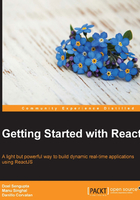
What this book covers
Chapter 1, Getting Started with ReactJS, is a brief overview of React about where to download and how to make it work on your web page. It will demonstrate how to create your first React component.
Chapter 2, Exploring JSX and the ReactJS Anatomy, will show the same simple react component, created in the first chapter, built with the JSX syntax. It'll explain the purpose of JSX and demystify its usage. It will compare some older template techniques to JSX and try to clarify some common questions about it.
Chapter 3, Working with Properties, will make you start developing your own app. It will use Facebook Open Graph API. This will cover how to configure it, get your friends' list, and render it using React. After this, we're going to break UI into small components.
Chapter 4, Stateful Components and Events, covers components that have state, practices to communicate between them, and how to respond to 'users' input/events in order to have UI reflect this state. This chapter also covers how the state changes your React UI performance with the Virtual DOM.
Chapter 5, Component Life cycle and Newer ECMAScript in React, explores what is the life cycle of such a React component. Furthermore, we will also dig into the future ECMA Script syntaxes and few changes that the React community also used from version 0.13.0. For this, we will review some ES6 and ES7 features within the react library.
Chapter 6, Reacting with Flux, will explain the flux architecture, which is used to build client-side web applications. It complements React's composable view components by using a unidirectional data flow. There is an in-depth explanation of all the components of the FLUX architecture (view, stores, action, and dispatchers).
Chapter 7, Making Your Component Reusable, will cover React good practices and patterns. This includes practices to develop reusable components, how to structure your components hierarchically to a better data flow and how to validate your components behavior.
Chapter 8, Testing React components, will show how to test your React code as this has never been so easy in React. To do so, we're going to unit test our app developed so far.
Chapter 9, Preparing Your Code for Deployment, tells us that React comes with a transformer for JSX that works on the fly. This should never be deployed in production though. This chapter will talk you through the ways of building those files offline using node libs, such as Webpack and Gulp.
Chapter 10, What's Next, explains some other advanced concepts, such as react-router, react-ajax, hot-reloading, redux, isomorphic apps, and so on.